If you like sunrises and sunsets, look for the green flash, a phenomenon that happens more often that you think.
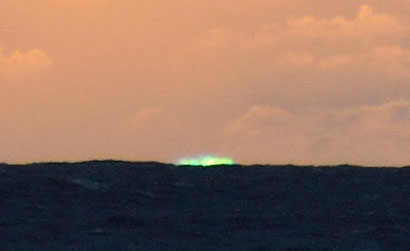
4un / CC BY-SA 3.0
Some sky phenomena are fairly common but rarely noticed because of their supposed difficulty or appearance at odd hours. Like the planet Mercury: Once you know when and where to look, it’s easy to find it at dusk or dawn multiple times each year.
I've found the same is true for the green flash, a brief but colorful atmospheric phenomenon that occurs at the moment of sunrise and sunset. For a second or two, the Sun’s upper rim can appear intensely green. Although called a “flash,” it's more a vividly green coloration to the first or last blip of the Sun visible at the horizon.
A friend of mine saw the flash for the first time while watching a sunset along the north shore of Lake Superior. He wasn’t even looking for it, but when it was over a second later, he turned to his paddling partner and asked “Did we just see the green flash?” Yes, they did! My first sighting was through a camera viewfinder, and I was equally surprised.
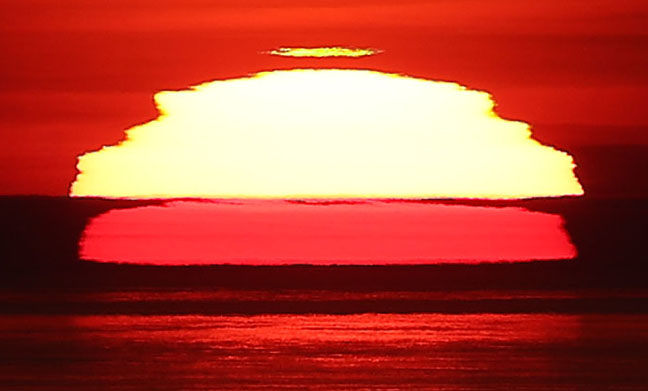
Bob King
To read about it, the flash would seem as rare a sight as a Venus transit, but this spring I discovered otherwise. You don't need perfect skies (a little haze or cloud is OK) or a tropical ocean, but you will need to be able to see down to within ½° or one full Moon diameter of the true horizon.
Most photos of the phenomenon are taken over the ocean or other large bodies of water, but there's no reason why it can't be seen over land provided the horizon is flat and distant. Mountaintops with a clear view across the plains should do the trick or even the flatlands of central Illinois, Kansas, and Nebraska.
While some haze is inevitable near the horizon, the sky doesn't have to be perfect. But if the Sun looks like a cherry-red ball, say from fire haze, you can safely cancel your green flash session. Best viewing occurs when the Sun remains yellow-orange toward the horizon and too bright for a quick glance.
The green flash didn’t get much attention from skywatchers until Jules Verne mentioned it in his novel Le Rayon Vert (The Green Ray). Verne wrote ecstatically about the color of the flash as “a most wonderful green, a green which no artist could obtain on his palette, a green of which neither the varied tints of vegetation nor the shades of the most limpid sea could ever produce the like! If there is a green in Paradise, it cannot but be of this shade, which most surely is the true green of Hope.”
Green flashes occur because the atmosphere refracts, or bends, light from the Sun, especially when it's near the horizon, where our line of sight traverses hundreds of miles of the lower atmosphere. Air is denser there and particularly so when our line of sight grazes the horizon.
A prism spreads sunlight into a rainbow of colors according to wavelength, from blue at one end to red at the other. Different colors of light are refracted by different amounts because they travel at slightly different speeds through the glass. Short wavelength violet travels slowest and suffers the strongest refraction compared to red light, which is refracted least.
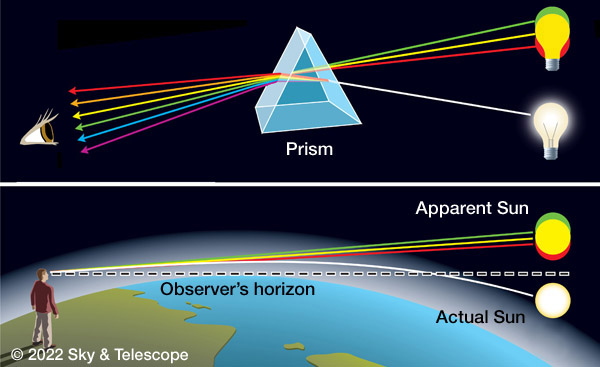
Sky & Telescope / Casey B. Reed
Dense air near the horizon acts as it own prism and spreads sunlight into a rainbow of closely overlapping images of the solar disk, each a different color from violet to red. The spreading of light according to color is called dispersion, and it’s small enough that most of those images overlap and produce white light . . . except at the very top and bottom of the solar disk. Blue and green, the most strongly refracted colors, stand highest above the horizon and fringe the Sun's top edge blue-green. Red, the least bent, forms a red fringe at the bottom.
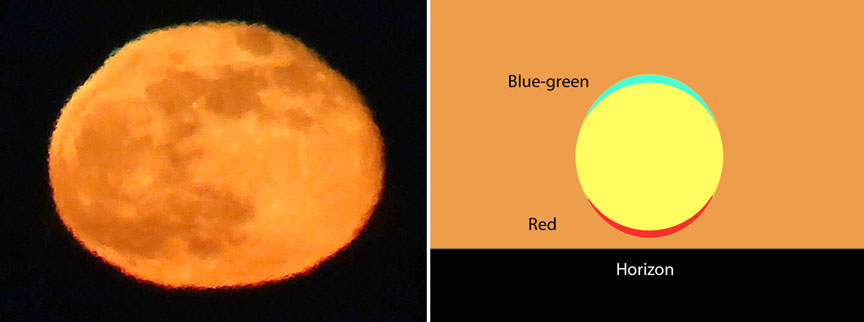
Bob King
Even a gibbous or full Moon will show dispersion when near the horizon. While challenging to see with the naked eye, binoculars will easily show the full Moon’s greenish-blue upper edge and reddish-purple bottom when viewed with minutes of moonrise. Try it out during the full Strawberry Moon on June 27–28.
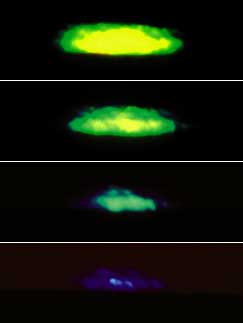
Pekka Parviainen
Since blue light is bent more than green light, why doesn’t the Sun’s edge look blue instead? Why not a blue flash? Blue light gets scattered away from the Sun by air molecules and lends its color to the blue sky, so it's generally not a player at sunset and sunrise. Rarely, under the clearest conditions, violet flashes have been recorded. I've seen just one blue-violet flash but more than a handful of green flashes in nearly as many sunrises this spring.
Because of obstructions in the western direction, nearly all my green flash sightings have been at sunrise over Lake Superior. Sunrises are a touch more challenging for viewing the flash than sunsets because you have to anticipate where the Sun will rise; at sunset you can see exactly where the last bit of Sun will set.
That said, it's pretty easy in practice. I get up a half hour before sunup, drive to an overlook, and focus my attention on the bright spot along the eastern horizon where the Sun will rise. Then I just have to wait for that glorious little bead of emerald green to pop. You can't miss it. The color is so vibrant and unexpected it can take your breath away. For sunset watchers, the flash appears as a last dab of lingering light as the solar disk drops out of sight.
© 2013 Juan Guerra
With clear skies and a good horizon, there’s no reason why the flash can’t be seen routinely. You need only keep your eye on the weather and show up. Take care to avoid looking directly at the solar disk because of potential damage to your eyesight. You'll also momentarily dazzle your retinas and end up trying to blink away afterimages obscuring your field of vision. Save your eyes for the last smidge of sunset or sunset, when it’s safe to look.
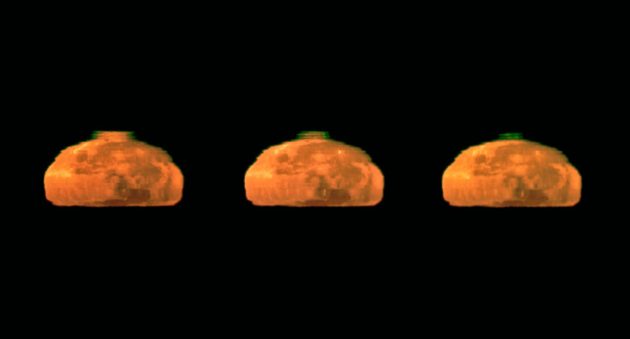
G.Hüdepohl (atacamaphoto.com) / ESO
Does the Moon also produce green flashes? While probably too faint to see with the unaided eye, lunar green flashes from the rising gibbous or full Moon have been seen in binoculars and recorded on camera. The same viewing rules apply: You need generally clear air, a distant and flat horizon, and to know just where to anticipate the moonrise. This link will provide moonrise and moonset times for your location; this one will give you the times of sunrise and sunset.
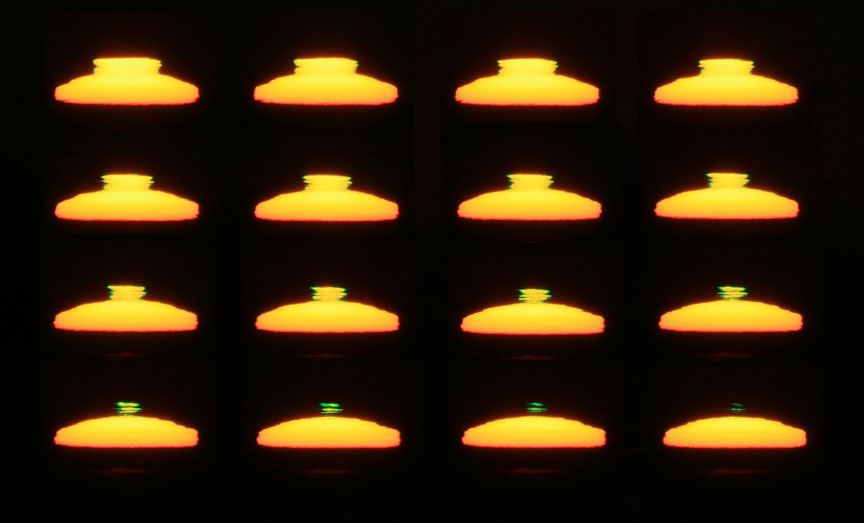
Mila Zincova / CC BY-SA 3.0
Mirages are common over large land surfaces and bodies of water, and they can make the green flash easier to see. An inferior mirage, better known as the “hot road” mirage, can isolate and expand the Sun’s green upper rim into a distinct patch of green light that appears to hover a second or two above the departing or rising Sun before evaporating into thin air.
Nature offers mesmerizing sights like the green flash for only a little effort. Go out and see for yourself what so excited Jules Verne that he was compelled to write a love story with the green flash as its central theme.
 8
8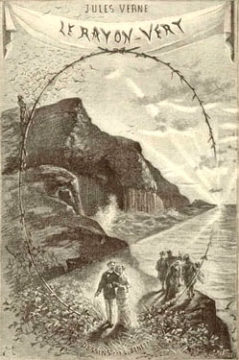









Comments
halfastro
June 20, 2018 at 12:40 pm
Yes, green flashes are fun to watch for and photograph. Most people expect something more dramatic than will really happen so they miss the subtle effects. Once on Kitt Peak, we were watching sunset witht the nightly guests and well before the bottom of the Sun hit the horizon, I saw a bright green come from the top of the Sun, similar to a green laser pointer. I almost doubted what I saw except that a few people gasped, said "Wow! WHAT WAS THAT?" Since several people saw it, I conclude it was a real and spectacular green flash.
I have photographed them many times. Here is a multiple green flash from Cerro Tololo Inter-American Observatory in Chile.
https://flic.kr/p/e3sNzB
The inferior mirage you mention frequently produces an omega sunset. If you see this, look for a green flash at the end!
https://flic.kr/p/suzEFm
You can see green flashes from Tucson as the Sun sets behind the mountains to the west. Sometimes you see multiple green flashes due to the jagged mountains.
https://flic.kr/p/pDHVKa
https://flic.kr/p/qy9qsQ
And one of my real prizes is that I know a few places around Tucson where I can go on certain dates and attempt to photograph green flashes as the Sun sets behind Kitt Peak...even get occasional blue and purple flashes.
https://flic.kr/p/hf3kCN
https://flic.kr/p/hcVJt1
https://flic.kr/p/pVZW2J
https://flic.kr/p/AmhZrQ
https://flic.kr/p/Q6zYC1
https://flic.kr/p/Q6A1iA
I have seen green flashes in many states with varied terrain so I definitely say go out and look wherever you are! Okay, that's enough for now...I like hunting these if you can't tell!
You must be logged in to post a comment.
Bob KingPost Author
June 20, 2018 at 12:50 pm
Thanks, Robert -- great stuff! I really like the multiple flash image - wow! Your comments will encourage others everywhere to give it a try themselves.
You must be logged in to post a comment.
Tom-Reiland
June 20, 2018 at 4:19 pm
As you pointed out, I also used to think that the Green Flash was only visible near a body of water. To my surprise, I was able to see my first from the hilltop where Wagman Observatory now stands. It's an excellent spot because it is one of the 4 highest locations in Allegheny County. Since then, I have seen many more, including one last week. Thanks for your post about this fascinating atmospheric event. Now others who have the same impression that did will be informed and can enjoy the show.
You must be logged in to post a comment.
Bob KingPost Author
June 21, 2018 at 2:41 pm
You're welcome, Tom. Again, it's useful for skywatchers to know the green flash is accessible from places other than bodies of water, so thanks for sharing your experience.
You must be logged in to post a comment.
John-Mosley
June 25, 2018 at 6:28 pm
I don't expect to be believed, but three times last year while observing with 4-inch binoculars from Borrego Springs, California, I saw the green flash as Venus set over mountains several miles away. The air was clear and dry. True story.
You must be logged in to post a comment.
Bob KingPost Author
June 26, 2018 at 12:10 am
John,
I honestly don't see why not. It would make sense though yours is the first I've heard of a Venus green flash.
You must be logged in to post a comment.
Alan Silverstein
July 6, 2018 at 4:26 pm
Venus -- Yes! And Jupiter too, if bright enough. I've seen the green flash from a setting planet many times, in the right conditions -- clear skies, bright planet, distant horizon. Much NICER than sunset flashes because you don't blind yourself watching for it.
You must be logged in to post a comment.
Kelly C.
July 20, 2018 at 3:39 pm
Back in the mid 1990's I worked for Prof Andrew Young of San Diego State University, taking pictures of the green flash from local coastal overlooks. Andy directed my work, giving me approximate camera settings(35mm with 500 mm lens) for the film I was using. I think I shot close to 50 rolls of Kodachrome 64 X 36 frames, (think Paul Simon's song "Kodachrome", giving you the greens' of summer) in conjunction with Andy, shooting different film (Ektachrome 100 with yellow filter) from different elevations above sea level.
Andy then had his graduate students analyze the shots, measuring the distortions, blobs and various refracted images (inferior, superior and ducted mirages) to produce at least a qualitative analysis of the phenomenon.)
He has a very informative academic web site that details his results and conclusions as well as all of his references and citations. There are examples of the differing types of green flash, animated graphics showing the differing pheromone as well as discussion of the relevant, past treatise on the subject.
Here in San Diego, the autumn is a very good time to see the green flash. With the meteorological, offshore 'Santa Anna' winds blowing all haze and water vapor out over the horizon, you're left with a very clear, relatively dry atmosphere to follow the Sun down to the cool air layer over the water horizon. That's where the magic happens!
The local surfing lore is full of stories regaling the magic of seeing the green flash. My story is one of coming home from a long day, stopping to check the waves and to watch the sunset at Windansea Beach, and seeing one of the best-ever, naked eye green flashes I've ever witnessed. It was the New Year's eve of the lunar cycle in the Year of the Dragon. The Dragon had given me a wink, foretelling good fortune in the coming year. Good karma for sure!
An Introduction to Green Flashes: https://aty.sdsu.edu/
You must be logged in to post a comment.
You must be logged in to post a comment.